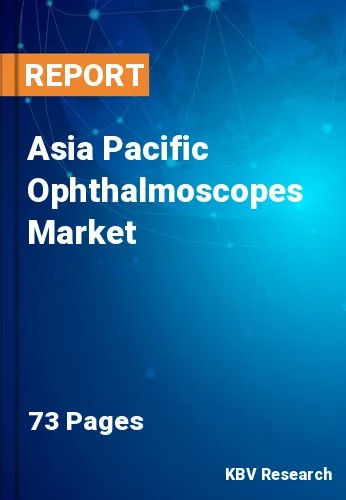The Asia Pacific Ophthalmoscopes Market would witness market growth of 7.0% CAGR during the forecast period (2022-2028).
Traditional ophthalmoscopes have a narrower field of view and lower magnification levels than monocular indirect ophthalmoscopes. As suggested by its name, the monocular indirect ophthalmoscope provides a single view of the eye's inner. For a physician to accurately evaluate a patient's ocular condition and fundus, the patient must look in various directions. Direct ophthalmoscopy provides the advantage of obtaining a direct, moderate to high-resolution fundus assessment. While secondary ophthalmoscopy is utilized to ensure the patient's retinal health, it does not require the administration of sedatives.
Formerly, ophthalmoscopes were enormous, bulky equipment used almost exclusively by doctors and optometrists. However, this equipment was not nearly as user-friendly as those of today. The modern ophthalmoscope is compact, lightweight, and, most critically, adaptable. The microscopic prisms at the unit's front allow the physician to focus light that enters the eye to determine the amount of eye movement. Furthermore, a bright, comforting light is provided to make the eye examination quite comfortable for the physician and the patient.
China has one of the world's most rapidly ageing populations. Due to higher life expectancy and lower fertility rates, China's population of individuals over 60 is anticipated to reach 28% by 2040. As a result, China has been investigating innovative methods for enhancing access to integrated care, such as developing an online medical information portal. A rapidly ageing population necessitates the creation of age-friendly towns and communities in which seniors can thrive & continue to make significant contributions to society. In the Asia-Pacific region, the expansion of the ophthalmoscopes market is predicted to be influenced by the ageing population, which increases the risk of eye-related disorders such as cataracts, and by government initiatives to give improved healthcare facilities to the older population.
The China market dominated the Asia Pacific Ophthalmoscopes Market by Country in 2021, and would continue to be a dominant market till 2028; thereby, achieving a market value of $27.4 Million by 2028. The Japan market is estimated to grow a CAGR of 6.3% during (2022 - 2028). Additionally, The India market would experience a CAGR of 7.6% during (2022 - 2028).
Based on End-use, the market is segmented into Hospitals, Ophthalmic Clinics, Others. Based on Type, the market is segmented into Direct and Indirect. Based on Application, the market is segmented into Glaucoma, Diabetic Retinopathy, Macular Degeneration, Retinal Repair and Others. Based on countries, the market is segmented into China, Japan, India, South Korea, Singapore, Malaysia, and Rest of Asia Pacific.
Free Valuable Insights: The Worldwide Ophthalmoscopes Market is Projected to reach USD 332.9 Million by 2028, at a CAGR of 6.3%
The market research report covers the analysis of key stake holders of the market. Key companies profiled in the report include Hill-Rom Holdings, Inc. (Welch Allyn) (Baxter International, Inc.), Keeler Ltd. (Halma Plc), Zumax Medical co. ltd, Albert Waeschle Limited, Neitz Instruments Co., Ltd., Iridex Corporation, HEINE Optotechnik GmbH & Co. KG, HONSUN Group, Nidek Co., Ltd., and Suzhou KangJie Medical, Inc.
By End-Use
By Type
By Application
By Country
Our team of dedicated experts can provide you with attractive expansion opportunities for your business.

